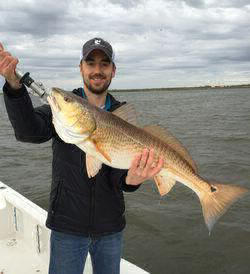
Big red Fish
by Mike Leonard, Conservation Director, American Sportfishing Association
If the Bassmaster Classic is the “Super Bowl of Bass Fishermen,” then the National Saltwater Recreational Fisheries Summit is the “Super Bowl of Marine Fisheries Policy Wonks.”
Held in Arlington, Va., on March 28-29, this gathering of over 100 fisheries managers, scientists and leaders in the saltwater recreational fishing community was an opportunity to discuss and collaborate on ideas to improve saltwater fisheries management and conservation. What it lacked in large crowds and dramatic weigh-ins, it made up for in PowerPoint presentations and stimulating breakout sessions. For a policy wonk like me, that’s about as exciting as it gets.
With the theme of “improving opportunity and stability in saltwater recreational fisheries,” this year’s summit had a level of optimism far beyond what I’ve experienced at past summits. As a community, we’re moving past the point of only complaining about our problems (although there was still a fair amount of valid criticism on display), to working through solutions.
The commitment from the Trump Administration to saltwater recreational fishing was evidenced by the participation of the Secretary of Commerce, the Acting Undersecretary of Commerce for Oceans and Atmosphere and the Assistant Administrator of NOAA Fisheries. Secretary Ross’s remarks in particular underscored that the nation’s 9 million saltwater anglers and their $63 billion economic impact are being taken seriously by this Administration. The recreational fishing community has a tremendous opportunity to take advantage of these favorable conditions to collaboratively advance management and data collection improvements that will result in better fishing opportunities.
Innovation on full display
One of the most fascinating presentations of the summit came from John Carmichael with the South Atlantic Fishery Management Council. While many parts of the country have struggled with managing recreational fisheries under stringent statutory requirements and insufficient data, this problem has been particularly acute in the southeastern U.S., where a lack of timely and quality fisheries data creates significant challenges for managing the region’s high species diversity and total number of anglers.
However, the South Atlantic Council is exploring innovative ways of better aligning fisheries regulations with current fisheries conditions using different metrics of abundance, with the aim of providing more stability and reasonable access. This approach requires more vetting, but it was encouraging to see a Council thinking outside the box on an idea that holds a lot of promise for improving federal management.
Another key theme to emerge from the summit was the potential for improving fisheries data through electronic reporting. Almost every angler these days has a smartphone, and while challenges exist in ensuring data provided by anglers is usable, there is growing interest among managers and anglers to figure out how to tap into this technology to provide more timely and accurate estimates of what’s being caught. Once again, the South Atlantic Council is thinking innovatively by testing voluntary electronic reporting in conjunction with reopening the red snapper fishery. While it’s not a panacea, electronic reporting can help significantly in providing managers with fisheries data they currently lack; a problem that is leading to overly precautionary management measures that limit access.
With great power comes great responsibility
I talked to several attendees who clearly were not accustomed to our community finally having such an ability to influence the fisheries management system. The saltwater recreational fishing community has been frustrated for many years over a federal marine fisheries management system that hasn’t given us a fair shake, leading to less access to marine fisheries resources than we feel we deserve. Now that we have an opportunity to fix that, some are concerned that we might go too far and lose sight of our roots as conservationists.
While I can understand where this concern is coming from, I certainly don’t see that being the direction our community is headed going into, or coming out of, this summit. The innovative management approaches being discussed aren’t about simply allowing us to kill more fish, but rather allowing access that’s better aligned with the actual abundance of fish stocks instead of overly precautionary guesses. That’s not anti-conservation, it’s anti-mismanagement.
The recreational fishing community’s continued commitment to conservation was prevalent at the summit, with important discussions on our leadership in improving the survival of released fish, conserving forage fish and restoring fisheries habitat.
Bill Shedd, President of AFTCO, summarized the current position of the saltwater recreational fishing community well in his keynote address: “I can tell you that right now is the best time in the last 40 years for all of us who are involved with fishery issues on behalf of the saltwater recreational fishing community… we have earned a bigger seat at the table and it is time for us to more confidently take that seat.”